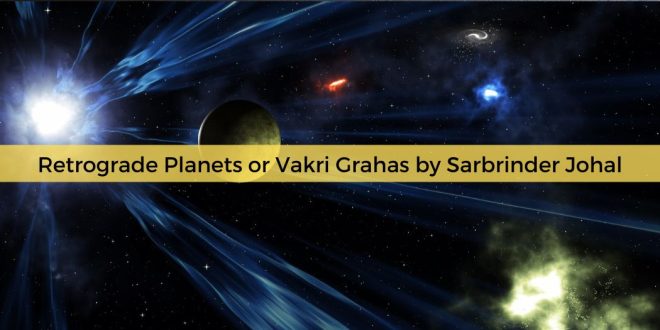Related Articles
RETROGRADE PLANETS OR VAKRI GRAHAS
BY
SARBRINDER JOHAL
As we know there are nine major planets which are considered for Falit Jyotish (Predictive Astrology) viz., Surya (Sun), Chandra (Moon), Budh (Mercury) Mangal (Mars), Guru (Jupiter), Shukra (Venus), Shani (Saturn) and Rahu (North node) and Ketu (South node) .
As our topic is related to retro or vakri grahas, let us first discuss which planets can be retrograde or vakri and then we will discuss how they become vakri and what is the result.
Surya and Chandra are the luminaries in Vedic astrology and they never are vakri or retro and this is the reason the Panchang and Vedic calendars are totally based upon Surya and Chandra.
Other planets viz., Budh and Shukra (inner planets) and Mangal, Guru and Shani (outer planets) do get vakri or retro. Rahu and Ketu are always vakri or retro in general but Mean Rahu and Ketu are considered as always vakri and True Rahu and Ketu do get margi or direct also, but we will keep it simple and we will consider them as always retro or vakri.
After this brief introduction about vakri or retrogression of planets let us understand what the word “retro” or “vakri” is and what does it mean.
Retrograde or Vakri means a planet that appears to move backwards, or is going backwards which we can notice in a gochar (transit) kundali easily …for example Mangal was vakri from 30th October 2022 till 12th of January 2023 or Budh was vakri from December 29th 2022 till January 18th 2023 in the sky.
Now the point is: does that planet really start to move backwards? Well, the answer is no, but as we look from the earth we feel / see that the planet is moving backwards. To understand this let us take some examples: suppose we are driving a car and we overtake another car it seems that the other car is going backward or when we travel in a train all the trees seems to go backward at a very high speed when we look out from the window . Hence the Sanskrit word vakri is used here which means indirect or opposite movement.
In the same way when the earth passes by a planet the planet seems to move backward and this is called a vakri or retro planet. All the planets are revolving in their orbits and hence when a planet is very close to earth and passes by it seems to appear as if it is moving backward. To understand this more effectively let us watch the following picture. As we know there are inner and outer planets hence the picture will clear the retro or vakri awastha (state).
First let us understand the zodiac and the nakshatras as placed in the sky. The following picture shows the Rashis in which the planets move during their pradakshina (orbit) of the Sun. And during the movement in these Rashis the planets appear to be vakri or retro …
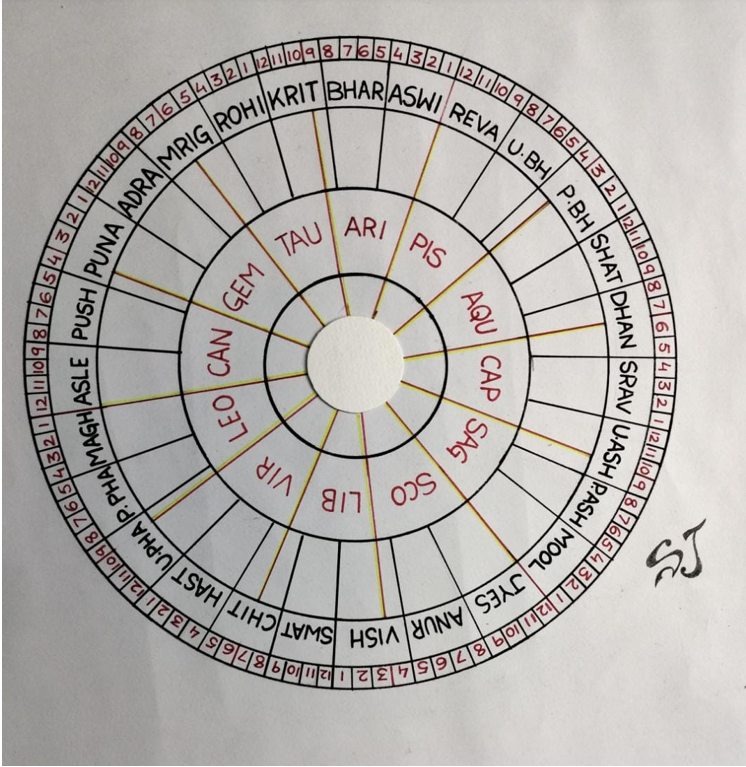
Pic Made by Sarbrinder Johal
Now let us understand how the planets seem to appear vakri or retro in a Rashi as we look from the Earth. Let us first try to understand the vakri awastha of outer planets viz Mangal, Guru and Shani.
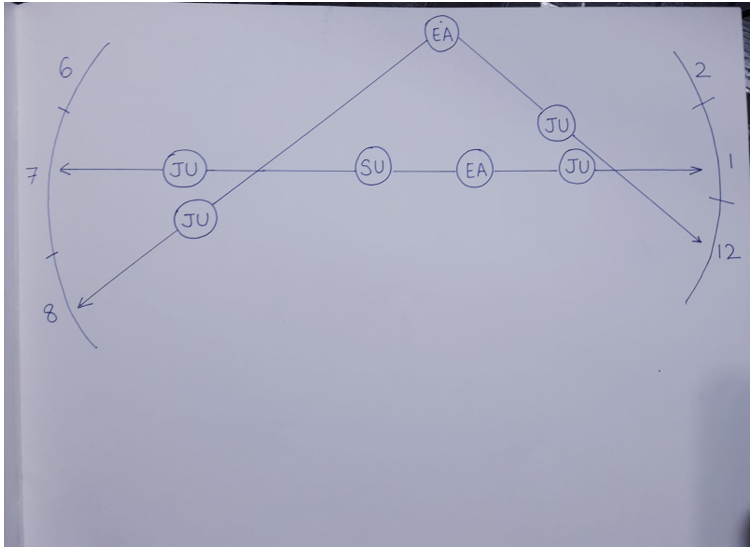
Pic by Sarbrinder Johal
In the above picture when we look at Guru from earth it seems to be visible in Aries/Mesh rashi as pointed by the arrow. Here we can clearly see that the earth is passing Guru, after some time both planets will move ahead but coz speed of earth is more than the speed of Guru. Now look at the another arrow which from earth is pointing towards Pisces/Meen rashi , hence now when we see from earth it seems as if Guru is in Meen rashi whereas Guru is actually moving ahead . This is applicable on all the outer planets viz Mangal Guru and Shani.
After understanding how the outer planets gets vakri or retro in the zodiac let us now understand from the below picture how we can easily tell if an outer planet is vakri or retro just by looking at the position of a planet or by its degree in the lagna kundali and then we will try to understand vakri awastha more deeply.
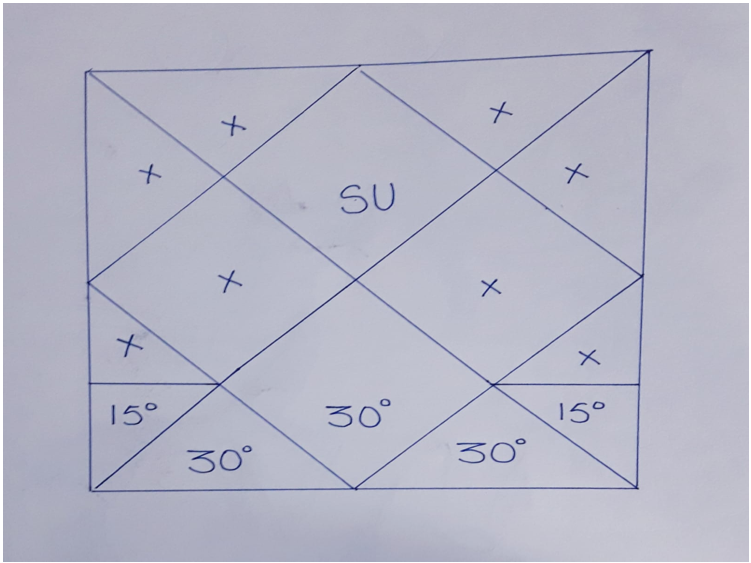
Pic by Sarbrinder Johal
The above picture easily shows where a outer planet can be vakri from Surya. Hence a planet maybe or may not be vakri if it is located 5th or 9th from Surya but a planet is 100% vakri when it is 6th 7th or 8th from the Surya and we know that all planets get combusted by Surya when they are with Surya. To elaborate more, for 5th and 9th planet from Surya it can be seen that the planet can’t be vakri in the first 15 degree if placed in 5th from Surya and can’t be vakri in last 15 degree if placed 9th from Surya .
Understanding this further, there are 3 types of motions of a vakri planet viz.,
Kutila – Stationary
Anu vakri – Less speed
Vakri – High speed
When an outer planet is 5th from Surya it is Kutila or stationary, when a planet is 6th from Sun it starts to gain speed or Anu vakri , when a planet is just opposite of Surya or 7th from Surya that is the top speed of planet and again when it is 8th from Surya the speed of the planet starts slowing down and then becomes stationary again in 9th from Surya. Hence actually the vakri outer planet which is just opposite to the Surya has the most chesta bala . Hence we should also consider if a vakri planet is 5th, 6th, 7th, 8th or 9th while making predictions or to check the result giving power. This is the reason the Rishi say that the planet just opposite to Surya will give full results, good or bad depending on the chart.
Here the Rishi also says that the shubh (auspicious) functional vakri planets become more shubh and functional ashubh(inauspicious) planets become more ashubh . Hence if 6th, 8th or 12th lord if vakri can be more dangerous (depending on lagna the 6th, 8th, 12th lord should be checked).
Now let us move to how inner planets become vakri . As we know that the inner planets can’t go more than two houses away from Surya ( Budh one house and Shukra two houses ) that means they can be vakri with the Sun and also one or two houses away from Surya too .
The following picture explains the vakri position in the sky for inner planets viz., Budh and Shukra.
In the following pic we can see that when we see Budh from Earth, the arrow shows that it is seen in Kark/Cancer Rashi. After some days Budh moves ahead and same with the Earth, but because the speed of Budh is faster than Earth, when we now look, the arrow is pointing in Mithun/Gemini Rashi but both the planets are moving ahead.
Further both Budh and Shukra can be combust and varki also and only vakri also. Hence these points also should be considered while making predictions or to check the result giving power
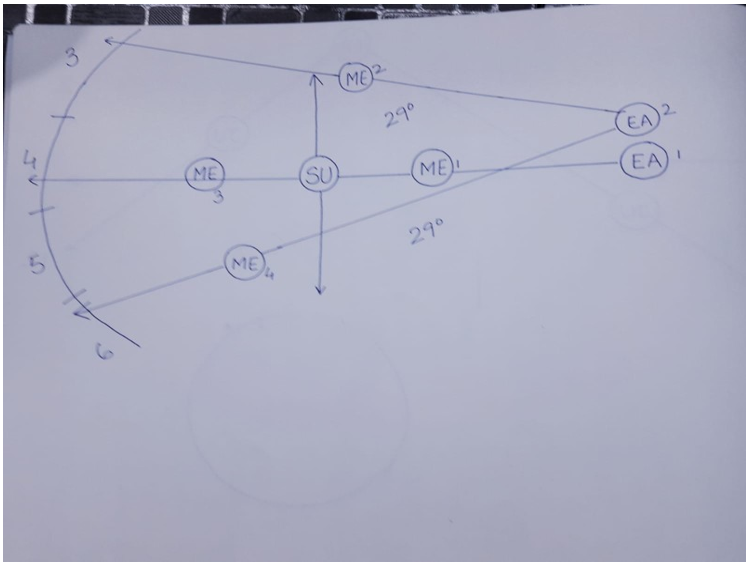
Views of different classics about a vakri or retro planet
Saravali says that if a functional subha grah is varki, it is considerd strong and is capable of giving Raj/Kingdom but if a functional malefic is retro or vakri it gives more malefic results.
Phaldeepika says if a planet is vakri and has full Rashmi/Rays it becomes strong even if it is in neech rashi , neecha navmansh , enemy sign or enemy navmansh hence is considered strong
BPHS says if a vakri grah is in 6th, 8th, 12th and gets aspected by malefics it is considered not good.
Edited by Ricardo Ribeiro
Sarbrinder Johal is an experienced and enthusiast Astrologer, fond of reading classics, a motivator, psychic and enthusiastic learner. He’s been studying Astrology for 12 years. Based out of Jharkhand, India, he has cultivated amazingly accurate Jyotish techniques from Jharkhand, Orrisa and Assam. Email: sarbrinderj@gmail.com
Learn Astrology: Join Our Upcoming Astrology Classes — Click Here
Learn Astrology: Join Our Recorded Astrology Classes — Click Here
 Saptarishis Astrology Magazine Into Creating Astrologers
Saptarishis Astrology Magazine Into Creating Astrologers

